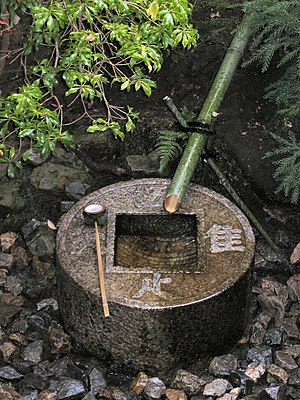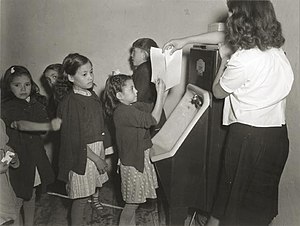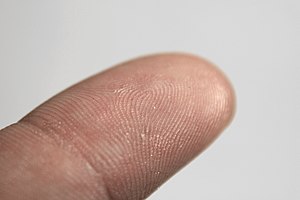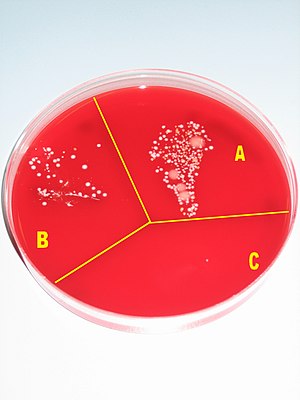Difference between revisions of "AY Honors/Home Nursing/Answer Key"
m (1 revision from w:Hand washing) |
m (346 revisions from w:Hand washing) |
Revision as of 04:10, 30 July 2008
Hand washing is the act of cleansing the hands with water or another liquid, with or without the use of soap or other detergents, for the sanitary purpose of removing soil and/or microorganisms.
Purpose
The main purpose of washing hands is to cleanse the hands of pathogens (including bacteria or viruses) and chemicals which can cause personal harm or disease. This is especially important for people who handle food or work in the medical field. The Centers for Disease Control and Prevention (CDC) has stated that "It is well-documented that the most important measure for preventing the spread of pathogens is effective handwashing." A large body of research is available on the topic.[1]
While there are some claims that hot water may more effectively clean one's hands, there is no documented evidence of this claim. The temperature at which humans can withstand hot water cannot kill germs. There are undocumented claims that hot water is more effective at removing dirt, oils and/or chemicals, but contrary to popular belief, it does not kill microorganisms. A temperature that is comfortable for hand washing (about Template:Convert) is not nearly hot enough to kill any microorganism. It takes a much higher temperature to effectively kill germs (typically Template:Convert).
Personal hand washing
To maintain good hygiene, hands should always be washed after using the toilet, changing a diaper, tending to someone who is sick, or handling raw meat, fish, or poultry, or any other situation leading to potential contamination. Hands should also be washed before eating, handling or cooking food. Conventionally, the use of soap and warm running water and the washing of all surfaces thoroughly, including under fingernails is seen as necessary. One should rub wet, soapy hands together outside the stream of running water for at least 20 seconds, before rinsing thoroughly and then drying with a clean or disposable towel.& After drying, a dry paper towel should be used to turn off the water (and open the exit door if one is in a restroom or other separate room). Moisturizing lotion is often recommended to keep the hands from drying out, should one's hands require washing more than a few times per day.&
Antibacterial soaps have been heavily promoted to a health-conscious public. To date, there is no evidence that using recommended antiseptics or disinfectants selects for antibiotic-resistant organisms in nature.& However, antibacterial soaps contain common antibacterial agents such as Triclosan, which has an extensive list of resistant strains of organisms. So, even if antibacterial soaps do not select for antibiotic resistant strains, they might not be as effective as they are marketed to be. These soaps are quite different from the non-water-based hand hygiene agents referred to below, which also do not promote antibiotic resistance.&
Medical hand washing
The purpose of hand washing in the health care setting is to remove or destroy (disinfect) pathogenic microorganisms ("germs") to avoid transmitting them to a patient. The application of water alone is ineffective for cleaning skin because water is unable to remove fats, oils, and proteins, which are components of organic soil. Therefore, removal of microorganisms from skin requires the addition of soaps or detergents to water. Plain soap does not kill pathogens. However, the addition of antiseptic chemicals to soap ("medicated" or "antimicrobial" soaps) does confer killing action to a hand washing agent. Such killing action may be desired prior to performing surgery or in settings in which antibiotic-resistant organisms are highly prevalent.&
The proper washing of hands in a medical setting generally consists of the use of generous amounts of soap and water to lather and rub each part of ones hands systematically for 15 to 20 seconds&. Hands should be rubbed together with digits interlocking. If there is debris under fingernails, a bristle brush is often used to remove it. Finally, it is necessary to rinse well and wipe dry with a paper towel. After drying, a dry paper towel should be used to turn off the water (and open any exit door if necessary).
To 'scrub' one's hands for a surgical operation, a tap that can be turned on and off without touching with the hands, some chlorhexidine or iodine wash, sterile towels for drying the hands after washing, and a sterile brush for scrubbing and another sterile instrument for cleaning under the fingernails are required. All jewellery should be removed. This procedure requires washing the hands and forearms up to the elbows, and one must in this situation ensure that all parts of the hands and forearms are well scrubbed several times. When rinsing, it is ensured at all times that one does not allow water to drip back from the elbow to your hands. When done hands are dried with a sterile cloth and a surgical gown is donned.
In the late 1990s and early part of the 21st century, non-water-based hand hygiene agents (also known as alcohol-based hand rubs, antiseptic hand rubs, or hand sanitizers) began to gain popularity. Most are based on isopropyl alcohol or ethanol formulated together with a thickening agent such as Carbomer, and a humectant such as glycerin into a gel, liquid, or foam for ease of use and to decrease the drying effect of the alcohol. The increasing use of these agents is based on their ease of use, rapid killing activity against microorganisms, and lower tendency to induce irritant contact dermatitis as compared to soap and water hand washing. Despite their effectiveness, the non-water agents do not clean hands of organic material, they simply disinfect them. However, disinfection does prevent transmission of infectious microorganisms. The commercial products of those include the brands of Aqium &, Germ Warfare &, Cuticura & etc and Rochon-Edouard et al. has provided a good review of those products &.
Visible soiling of any sort on the hands must be washed with soap and water because alcohol-based hand rubs are ineffective in the presence of organic material. In addition, alcohols are ineffective against non-lipid-enveloped viruses (e.g., Noroviruses) and the spores of bacteria (e.g., Clostridium difficile) and protozoa (e.g., Giardia lamblia). When such microorganisms are likely to be encountered, soap and water hand washing is preferable.
The New England Journal of Medicine reports that lack of hand washing remains at unacceptable levels in most medical environments, with large numbers of doctors and nurses routinely forgetting to wash their hands before touching patients.& One study has shown that proper hand washing and other simple procedures can decrease the rate of catheter-related bloodstream infections by 66 percent.&
World Health Organization has published a sheet which demonstrates the standard procedures of handwashing and handrubing in health care sectors &. The draft guidance of hand hygiene by the organization can also be found at its website for public comment &. A relevant review is conducted by Whitby et al. &. Further more, there are some commercial devices available on markets, which measure and validate the hand hygiene, if regulatory compliances are must &.
Truths, myths, and misinformation
- Alcohol-free hand sanitizers are not as effective as alcohol hand rubs
- This is misinformation
The efficacy of alcohol-free hand sanitizers are heavily dependent on their ingredients and formulation. In the past, alcohol-free hand sanitizers tended to significantly under-perform alcohol or alcohol rubs as germ killers in clinical studies using standard protocols such as EN1500. More recently, advanced formulations have been developed, some of which have been shown to out-perform alcohol. A further aspect of efficacy that is sometimes overlooked is the effect of repeated use. The efficacy of alcohol as a hand disinfectant has been shown to decrease after repeated use, thought to be due to progressive adverse skin reactions, whereas the efficacy of an alcohol-free hand sanitizer based on Benzalkonium Chloride as its active ingredient has been shown to increase with repeated use. &
- Washing your hands with soap and water kills germs
- This is misinformation
Plain soaps have minimal if any antimicrobial activity. In several clinical studies, hand washing with plain soap failed to remove bad microorganisms (pathogens) from the hands of hospital personnel. Hand washing with plain soap can result in an increase in bacterial counts on the skin. Occasionally, contaminated plain soaps have colonized hands with Gram-negative bacteria.&
- Killing germs on your hands decreases your immunity
- This is a myth
The skin on your body is covered with microorganisms. Our environment is contaminated with good and bad microorganisms. You cannot kill all of the microorganisms on your hands. Your large intestine contains large numbers of microorganisms. All of these sources of germs stimulate your immune response. CDC guidelines for health care workers call for alcohol rubs to be used 60 or more times a day between patients and after touching contaminated surfaces. Killing germs on your hands will not decrease your immunity but it will help prevent disease.&
- Alcohol rub hand sanitizers do not kill germs
- This is misinformation
Hand sanitizers containing a minimum of 60 to 95% alcohol are very efficient germ killers. Alcohol rub sanitizers kill bacteria, multi-drug resistant bacteria (MRSA and VRE), tuberculosis, and viruses (including HIV, herpes, RSV, rhinovirus, vaccinia, influenza, and hepatitis) and fungus. Alcohol rub sanitizers containing 70% alcohol kill 3.5 log10 (99.9%) of the bacteria on hands 30 seconds after application and 4 to 5 log10 (99.99 to 99.999%) of the bacteria on hands 1 minute after application. Alcohol rub sanitizers can prevent the transfer of health-care associated pathogens (Gram-negative bacteria) better than soap and water. Alcohol rub sanitizers are not appropriate for use when your hands are visibly dirty, soiled or contaminated with blood. Use soap and water for dirty or soiled hands.&
- Don’t kill the good germs — the good germs protect our hands from the bad germs
- This is a myth
Good germs are microorganisms normally found on human skin and bad germs are pathogenic (disease producing) microorganisms. The numbers of good germs and bad germs on the hands are variable from one person to the next but remain relatively constant for each individual. Good germs cannot protect you against bad germs. Anyone can become contaminated with bad germs (pathogens). Bad germs (pathogens) do not always cause disease and good germs can, under the right conditions, cause disease.&&
- Alcohol will dissolve the natural oils on your skin and cause dry skin
- This is true
Frequent use of alcohol-based formulations for hand sanitizers can cause dry skin unless emollients and/or skin moisturizers are added to the formula. The drying effect of alcohol can be reduced or eliminated by adding glycerin and/or other emollients to the formula. In several prospective clinical trials, alcohol based hand sanitizers containing emollients caused substantially less skin irritation and dryness than soaps or antimicrobial detergents. Allergic contact dermatitis, contact urticaria syndrome or hypersensitivity to alcohol or additives present in alcohol hand rubs rarely occurs.&&
- Alcohol rubs cause (bacterial) mutation and resistance
- This is misinformation
Dead microorganisms don’t mutate. Alcohol rubs (biocides) kill microorganisms. Current scientific evidence has not shown a link exists between the use of topical antimicrobial formulations and antiseptic or antibiotic resistance. Antiseptics (biocides) have multiple (thousands) of nonspecific killing sites on and in the microbial cell which cannot easily mutate. Antibiotics and antibacterial soaps (triclosan) have one very specific killing site on and in the microbial cell which can easily mutate. Antibiotic resistance has no effect on the effectiveness of antiseptics.&&
- Alcohol rub and combination hand sanitizers kill germs better than soap and water
- This is true
Alcohol rubs and combination hand sanitizers are effective at killing germs on your hands, but not effective at removing dirt. Conversely, soap and water are very effective at cleaning dirty or soiled hands, but are not good at killing germs (as discussed above).&
- Alcohol rubs with two germ killers are significantly more effective germ killers than alcohol rubs with one germ killer
- This is true
Many clinical studies have shown that alcohol rubs containing two germ killers (ie. Alcohol and Chlorhexidine gluconate or Benzalkonium chloride) are significantly better germ killers than alcohol rubs containing alcohol alone.&
Hand washing as compensation
Excessive hand washing is commonly seen as a symptom of obsessive-compulsive disorder (OCD).
It has also been found that people, after having recalled or contemplated unethical acts, tend to wash hands more often than others, and tend to value hand washing equipment more. Furthermore, those who are allowed to wash their hands after such a contemplation are less likely to engage in other "cleansing" compensatory actions, such as volunteering.&&
Symbolic hand washing

Ritual handwashing is a feature of many religions, including Bahá'í Faith, Hinduism and tevilah and netilat yadayim in Judaism. Similar to these are the practises of Lavabo in Christianity, Wudu in Islam and Misogi in Shintō.
Idioms
When someone "washes their hands of" something, this means that they are declaring their unwillingness to take responsibility for it or share complicity in it. Matthew 27:24 gives an account of Pontius Pilate washing his hands of the decision to crucify Jesus: "When Pilate saw that he could prevail nothing, but that rather a tumult was made, he took water, and washed his hands before the multitude, saying, I am innocent of the blood of this just person: see ye to it."
In Shakespeare's Macbeth, Lady Macbeth begins to compulsively wash her hands in an attempt to cleanse an imagined stain, representing her guilty conscience regarding crimes she had committed and led her husband to commit.
See also
- Antibacterial soap
- E. coli O157:H7
- Antibiotic resistance
- Ignaz Semmelweis
- Soap dispenser
- Methicillin-resistant Staphylococcus aureus
- Rubbing alcohol
- Patient safety
- Occupational biosafety
References
- ↑ Hand washing from Mayo Clinic
- ↑ Hand washing from Tufts University
- ↑ Template:Cite journal
- ↑ Clean hands from the CDC
- ↑ WHO Guidelines on Hand Hygiene in Health Care
- ↑ APIC Guidelines for handwashing and hand antisepsis in health care settings. American Journal of Infection Control. 1995;23:251-269
- ↑ Ego Pharmaceuticals Pty Ltd. "Aqium Gel". http://www.egopharm.com/Products.asp?ProductID=31&RangeID=18. Retrieved 22 July 2008.
- ↑ Paragon PE Ltd. "Germ Warfare". http://www.germwarfare.co.uk/. Retrieved 22 July 2008.
- ↑ Cuticura. "Cuticura Anti Bacterial Hand Hygiene Gel". http://www.cuticura.co.uk/. Retrieved 22 July 2008.
- ↑ 10.0 10.1 Template:Cite journal Cite error: Invalid
<ref>tag; name "cvvs" defined multiple times with different content - ↑ Template:Cite journal
- ↑ Template:Cite journal
- ↑ World Health Organization. "How to Handrub & How to Handwash". http://www.who.int/gpsc/tools/GPSC-HandRub-Wash.pdf. Retrieved 21 July 2008.
- ↑ World Health Organization. "WHO Guidelines on Hand Hygiene in Health Care (Advanced Draft)". http://www.who.int/patientsafety/information_centre/Last_April_versionHH_Guidelines%5B3%5D.pdf. Retrieved 21 July 2008.
- ↑ Online Science Mall. "Ultraviolet LED Flashlight Blacklight - Good with Glo Germ Simulated Germs 21LED". http://www.onlinesciencemall.com/Shop/Control/Product/fp/vpid/2679076/vpcsid/0/SFV/30852. Retrieved 21 July 2008.
- ↑ AORN; Dyer, etal; Aug 1998; VOL 68, No2;http://www.aornjournal.org/article/abstracts?terms1=&terms2=&terms3=
- ↑ 17.0 17.1 17.2 17.3 "Hand Hygiene for Healthcare Workers". LearnWell Resources, Inc, a California nonprofit public benefit 501(c)(3) corporation. http://www.learnwell.org//handhygiene.htm. Retrieved 2007-04-27.
- ↑ Template:Cite journal
- ↑ Template:Cite journal
- ↑ 20.0 20.1 Template:Cite journal
- ↑ Template:Cite journal
- ↑ Template:Cite journal
- ↑ "Alcohol Hand Rub and Hand Hygiene". Clinical Excellence Commission, Health, New South Wales, Australia. http://www.cec.health.nsw.gov.au/pdf/AlcoholHandRub061013.pdf. Retrieved 2007-04-27.
- ↑ Benedict Carey. Lady Macbeth Not Alone in Her Quest for Spotlessness. The New York Times, 12 September 2006
- ↑ Template:Cite journal
External links
de:Händedesinfektion fr:Hygiène des mains mn:Гар угаалт ja:手洗い simple:Hand washing sv:Handtvagning



